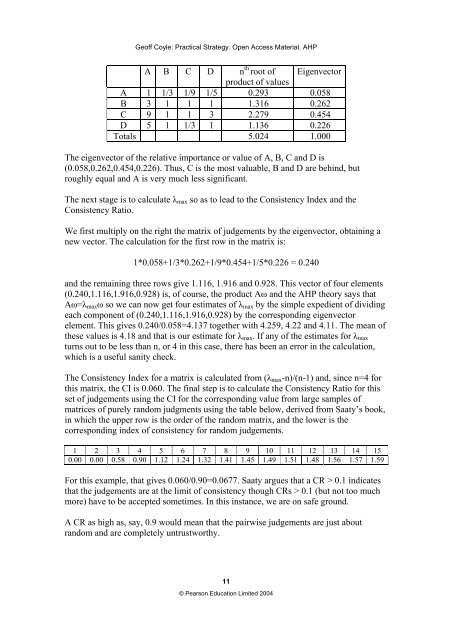THE ANALYTIC HIERARCHY PROCESS (AHP)
THE ANALYTIC HIERARCHY PROCESS (AHP)
THE ANALYTIC HIERARCHY PROCESS (AHP)
You also want an ePaper? Increase the reach of your titles
YUMPU automatically turns print PDFs into web optimized ePapers that Google loves.
Geoff Coyle: Practical Strategy. Open Access Material. <strong>AHP</strong><br />
A B C D n th root of<br />
product of values<br />
Eigenvector<br />
A 1 1/3 1/9 1/5 0.293 0.058<br />
B 3 1 1 1 1.316 0.262<br />
C 9 1 1 3 2.279 0.454<br />
D 5 1 1/3 1 1.136 0.226<br />
Totals 5.024 1.000<br />
The eigenvector of the relative importance or value of A, B, C and D is<br />
(0.058,0.262,0.454,0.226). Thus, C is the most valuable, B and D are behind, but<br />
roughly equal and A is very much less significant.<br />
The next stage is to calculate λmax so as to lead to the Consistency Index and the<br />
Consistency Ratio.<br />
We first multiply on the right the matrix of judgements by the eigenvector, obtaining a<br />
new vector. The calculation for the first row in the matrix is:<br />
1*0.058+1/3*0.262+1/9*0.454+1/5*0.226 = 0.240<br />
and the remaining three rows give 1.116, 1.916 and 0.928. This vector of four elements<br />
(0.240,1.116,1.916,0.928) is, of course, the product Aω and the <strong>AHP</strong> theory says that<br />
Aω=λmaxω so we can now get four estimates of λmax by the simple expedient of dividing<br />
each component of (0.240,1.116,1.916,0.928) by the corresponding eigenvector<br />
element. This gives 0.240/0.058=4.137 together with 4.259, 4.22 and 4.11. The mean of<br />
these values is 4.18 and that is our estimate for λmax. If any of the estimates for λmax<br />
turns out to be less than n, or 4 in this case, there has been an error in the calculation,<br />
which is a useful sanity check.<br />
The Consistency Index for a matrix is calculated from (λmax-n)/(n-1) and, since n=4 for<br />
this matrix, the CI is 0.060. The final step is to calculate the Consistency Ratio for this<br />
set of judgements using the CI for the corresponding value from large samples of<br />
matrices of purely random judgments using the table below, derived from Saaty’s book,<br />
in which the upper row is the order of the random matrix, and the lower is the<br />
corresponding index of consistency for random judgements.<br />
1 2 3 4 5 6 7 8 9 10 11 12 13 14 15<br />
0.00 0.00 0.58 0.90 1.12 1.24 1.32 1.41 1.45 1.49 1.51 1.48 1.56 1.57 1.59<br />
For this example, that gives 0.060/0.90=0.0677. Saaty argues that a CR > 0.1 indicates<br />
that the judgements are at the limit of consistency though CRs > 0.1 (but not too much<br />
more) have to be accepted sometimes. In this instance, we are on safe ground.<br />
A CR as high as, say, 0.9 would mean that the pairwise judgements are just about<br />
random and are completely untrustworthy.<br />
11<br />
© Pearson Education Limited 2004


